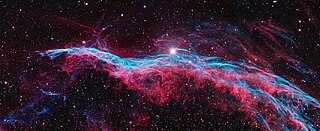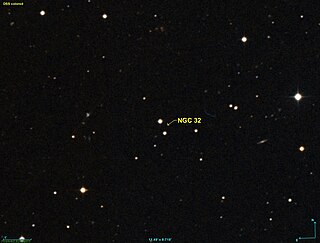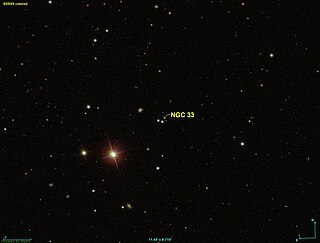
Ara, the southern constellation between Scorpius, Telescopium, Triangulum Australe and Norma, was one of the Greek bulk described by the 2nd-century astronomer Ptolemy, and it remains one of the 88 modern constellations defined by the International Astronomical Union.

Dorado is a constellation in the southern sky. It was named in the late 16th century and is now one of the 88 modern constellations. Its name refers to the dolphinfish, which is known as dorado in Portuguese, although it has also been depicted as a swordfish. Dorado contains most of the Large Magellanic Cloud, the remainder being in the constellation Mensa. The South Ecliptic pole also lies within this constellation.

Sagittarius is one of the constellations of the zodiac and is located in the Southern celestial hemisphere. It is one of the 48 constellations listed by the 2nd-century astronomer Ptolemy and remains one of the 88 modern constellations. Its name is Latin for the archer, and its symbol is , a stylized arrow. Sagittarius is commonly represented as a centaur pulling back a bow. It lies between Scorpius and Ophiuchus to the west and Capricornus and Microscopium to the east.

Triangulum is a small constellation in the northern sky. Its name is Latin for "triangle", derived from its three brightest stars, which form a long and narrow triangle. Known to the ancient Babylonians and Greeks, Triangulum was one of the 48 constellations listed by the 2nd century astronomer Ptolemy. The celestial cartographers Johann Bayer and John Flamsteed catalogued the constellation's stars, giving six of them Bayer designations.

Cassiopeia is a constellation in the northern sky, named after the vain queen Cassiopeia in Greek mythology, who boasted about her unrivaled beauty. Cassiopeia was one of the 48 constellations listed by the 2nd-century Greek astronomer Ptolemy, and it remains one of the 88 modern constellations today. It is easily recognizable due to its distinctive 'W' shape, formed by five bright stars.

NGC 1, also occasionally referred to as GC 1, UGC 57, PGC 564 or Holm 2a is an intermediate spiral galaxy of the morphological type Sbc, located approximately 210 to 215 million light-years from the Solar System in the constellation Pegasus. It was discovered on 30 September 1861 by Heinrich d'Arrest.

NGC 7027 is a very young and dense planetary nebula located around 3,000 light-years from Earth in the constellation Cygnus. Discovered in 1878 by Édouard Stephan using the 800 mm (31 in) reflector at Marseille Observatory, it is one of the smallest planetary nebulae and by far the most extensively studied.

NGC 1097 is a barred spiral galaxy about 45 million light years away in the constellation Fornax. It was discovered by William Herschel on 9 October 1790. It is a severely interacting galaxy with obvious tidal debris and distortions caused by interaction with the companion galaxy NGC 1097A. Three supernovae have been observed in NGC 1097 since 1992.

NGC 7380 is an open cluster discovered by Caroline Herschel in 1787. William Herschel included his sister's discovery in his catalog, and labelled it H VIII.77. It is also known as 142 in the 1959 Sharpless catalog (Sh2-142). This reasonably large nebula is located in Cepheus. It is extremely difficult to observe visually, usually requiring very dark skies and an O-III filter.

The Veil Nebula is a cloud of heated and ionized gas and dust in the constellation Cygnus.
NGC 103 is a small open cluster. It is partially visible in an 8" amateur telescope under moderately light polluted skies. It is roughly 4600 light-years from the Sun.

NGC 4889 is an E4 supergiant elliptical galaxy. It was discovered in 1785 by the British astronomer Frederick William Herschel I, who catalogued it as a bright, nebulous patch. The brightest galaxy within the northern Coma Cluster, it is located at a median distance of 94 million parsecs from Earth. At the core of the galaxy is a supermassive black hole that heats the intracluster medium through the action of friction from infalling gases and dust. The gamma ray bursts from the galaxy extend out to several million light years of the cluster.

Gemini is one of the constellations of the zodiac and is located in the Northern celestial hemisphere. It was one of the 48 constellations described by the 2nd century AD astronomer Ptolemy, and it remains one of the 88 modern constellations today. Its name is Latin for "twins," and it is associated with the twins Castor and Pollux in Greek mythology. Its symbol is .

NGC 2129 is an open cluster in the constellation Gemini. It has an angular distance of 2.5 arcminutes and is approximately 2.2 ± 0.2 kpc from the Sun inside the Local spiral arm. At that distance, the angular size of the cluster corresponds to a diameter of about 10.4 light years. NGC 2129 is a very young cluster whose age has been estimated at 10 million years.

NGC 32 is a pair of G7 yellow dwarf stars in the constellation Pegasus. Although at a similar distance, the stars are physically unrelated. The dimmer, southern star is 2501±92 light-years from the Sun, while the brighter, northern star is 2927±88 light-years from the Sun.

NGC 33 is a double star system in the constellation Pisces. While in apparent proximity to each other, the stars are likely physically unrelated to each other. The eastern star is 4020±520 light-years from the Sun, while the western, brighter star is 5560±580 light-years from the Sun. However, they have relatively similar proper motions, so their relationship is unclear.
NGC 44 is a binary star system located in the Andromeda constellation. It was first recorded by John Herschel on November 22, 1827. He noted "not to be seen but in the clearest night" and that it was "extremely faint, very small". Although the stars appear to be at a similar distance, their motion is extremely different from each other. The eastern star is approximately 3430±200 light-years away, while the western star is approximately 3440±210 light-years away. While the distances seem similar, the error bars mean the stars could just as easily be 3230 and 3650 light-years from the Sun, or 3630 and 3230 light-years from the Sun.

NGC 6300 is a barred Seyfert spiral galaxy located in the constellation Ara. It is designated as SB(rs)b in the galaxy morphological classification scheme and was discovered by the Scottish astronomer James Dunlop on 30 June 1826. NGC 6300 is located at about 51 million light years away from earth. It is suspected that a massive black hole may be at its center, pulling all the nearby objects into it. In turn, it emits large amounts of X-rays.

NGC 511, also occasionally referred to as PGC 5103 or UGC 936, is an elliptical galaxy in the constellation Pisces. It located approximately 499 million light-years from the Solar System and was discovered on 26 October 1876 by French astronomer Édouard Stephan.

NGC 513, also occasionally referred to as PGC 5174 or UGC 953, is a spiral galaxy in the constellation Andromeda. It is located approximately 262 million light-years from the Solar System and was discovered on 13 September 1784 by astronomer William Herschel.


















